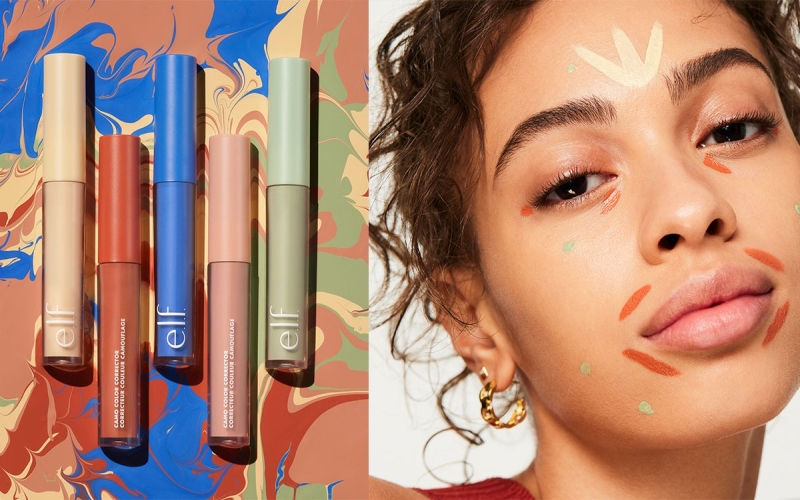Colour correcting in makeup is a great way to enhance your natural beauty and create a flawless finish. If you’re new to it, don’t worry—colour correction is easier than it sounds, and with the right techniques, you can master it in no time!
In this blog, we’ll cover some basic tips on how to use colour correctors to hide blemishes, redness, and other imperfections. Plus, we’ll throw in some extra tips for beginners.
What Is Colour Correcting?
Colour correction is a process wherein you use coloured concealers or even prime with these colours to neutralise any imperfections on the skin. The basic idea is that opposite colours cancel each other. Green cancels redness, and purple wipes out yellow tones. By placing the right colour in the correct places on the face, you can even out your complexion and give a better base for the foundation.
1. Select a Suitable Colour Corrector
You will first need to know which colours to use based on your skin concerns. Here is a handy guide to the most common colour correctors and what they address:
- Green: Ideal to counter redness due to acne, rosacea, and sunburn.
- Purple or lilac: It neutralises dull yellow undertones, perfect for individuals with sallow-looking skin.
- Peach or Orange: Great for covering up dark spots, hyperpigmentation, or blue-toned under-eye circles.
- Yellow: Helps to neutralise purple or blue tones, great for covering bruises or dark circles.
- Pink: A lighter option for brightening dull skin or masking dark circles, especially for fair skin.
2. Apply the Corrector First
When you’re ready to colour correct, it’s important to apply the corrector before your foundation. Use a small amount of the chosen corrector and apply it directly to the areas that need it.
Gently blend it into your skin using your fingers, a makeup sponge, or a brush. Make sure not to rub it in too much—just tap it until it melts into your skin. This will create a smooth base for your foundation to go on top of.
3. Less Is More
A common mistake beginners make is to overlay colour correctors. A little goes a long way! You want to apply just enough to counteract the imperfection but not so much that it is seen once you apply foundation. The idea is that it should fade into your skin tone once done. Remember, most of the colour will be covered with foundation.
4. Focus on Specific Areas
Target Regions When one applies the colour correctors, one focuses on the targeted region alone. For example, areas that are red, like around the nose or across the cheeks, would benefit most from a green corrector being applied just to that area.
Under-eye circles can be corrected with a peach or orange corrector. And for dark spots and pigmentation, peach or yellow should be applied with a bit of targeting.
5. The right tools make a difference
Invest in good tools for the best results. A makeup sponge or brush is best suited for blending colour corrector into your skin. If you’re prone to sensitive skin around the eyes or nose, use a soft, synthetic brush that won’t irritate. It’s also a good idea to use a sponge that is damp when blending your corrector; it’ll help avoid patchiness and provide a smooth finish.
6. Don’t Forget About Setting Powder
Apply setting powder using a translucent powder over your foundation and concealer. This can be done to help avoid makeup smearing all day or spreading across a person’s face due to oiliness. Make sure you use your powder very lightly, targeting oily areas or areas where you used the corrector.
7. How to Conceal Dark Circles
Many people experience dark circles, and colour correction can be very beneficial here. The coverage of dark circles is absolutely determined by the right shade. For people whose under-eye circles are blue or purple, the peach or orange corrector works best to counterbalance the problematic tone.
Peach suits light skin tones, but a darker orange for people with much darker skin tones is ideal.
For newbies, the Best Dark Circle Corrector is likely going to be a creamy one that blends easily. The right corrector should have good coverage and not feel heavy or cakey.
Following up your colour corrector application with a brightening concealer that matches your skin tone really helps to blend everything.
8. Special Tips for Hooded Eyes
If you have hooded eyes, colour correcting can help brighten and open up the eyes. Neutralise dark circles under your eyes with a peach or orange shade. You can also apply a light layer of yellow or peach corrector right on eyelids, counteracting the redness or discoloration.
This might be enough to make your eyes look wider awake and fresh. The important thing when applying makeup on hooded eyes is you set it with a good primer.
9. Never Skip Foundation
Once you have applied your colour corrector, foundation time. Choose a formula that best fits your skin type either dewy, matte or somewhere in between. Ensure the foundation that will be applied blends really well with the colour corrector that was just applied, so make sure to use a colour closest to your skin tone.
10. Finish with Brightening Concealer
Lastly, after your foundation is in place, apply a brightening concealer to any areas that may need extra coverage, such as under the eyes, around the nose, or on any blemishes. Blend it well, and you’re good to go!
Conclusion
Colour correcting is another wonderful tool that begins to spice up the mundane makeup routine. With the right techniques and tools, you would achieve a smooth, effortless finish. Remember that you should apply the corrector first, use it sparingly, and focus on the specific areas that need it most. Before you know it, you will be a colour-correcting pro!
